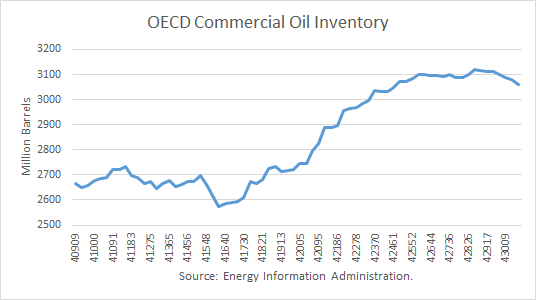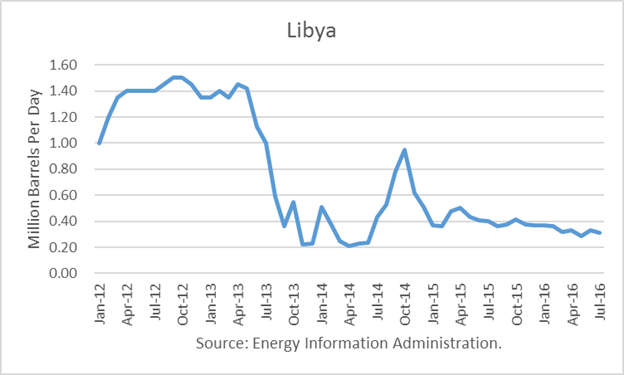
The Energy Information Administration (EIA) recently released its September Short-Term Energy Outlook (STEO) and its projects that world supply and demand will finally balance by late 2017. However, that depends on OPEC production rising a very small amount.
Base Case Scenario
Specifically, the EIA reported that OPEC crude production averaged 32.7 million barrels per day (mmbd) in August, and it projects OPEC production to average 32.95 mmbd in 2017. Under that scenario, world supply meets demand of 97.8 million barrels per day, and total inventories end 2017 at 3.062 billion barrels, about 350 million barrels higher than normal.

The 2017 demand figure represents a gain of 1.5% from estimated demand in 2016 of 95.88 mmbd, which is a gain of 1.6% over 2015. This assumes a healthy macroeconomic environment. For example, the EIA is projecting that US GDP gains 2.6% in 2017, much better than the 1.5% GDP gain EIA assumes in 2016.
It also assumes that China oil demand increases another 3.4% in 2017, the same gain as in 2016. And it assumes India and other Asia’s oil demand rises by 4.4% in 2017, a little slower than in 2016.
The EIA is projecting that non-OPEC supply dips by 0.4% in 2017. That is on top of the drop of 0.7% in 2016.
Supply Risks
The supply-demand balance assumes OPEC limits its gain in production to 250,000 b/d. However, various members are trying to restore or increase output substantially.
Libya’s output fell to just 300,000 b/d due to its civil war. Oil production in Libya may return to the pre-crisis level of 1.6 million barrels per day within a year, Deputy Prime Minister of the Libyan Government of National Accord Musa Koni told Sputnik. A gain of 1.3 mmbd would deepen the glut.

Crude oil production disruptions in Nigeria were still about 500,000 barrels per day (b/d) in August. The country will try to restore output to 2 mmbd as soon as it can.
Venezuela’s production has fallen about 300,000 b/d due to crisis conditions and a draught. It will attempt to restore production in 2017.
Iran most recently reported its production at 3.6 mmbd, below its pre-sanction target of 4.0-4.2 mmbd. Its five-year goal is to increase production to about 4.8 mmbd.
In Iraq, BP, Shell and Lukoil have agreed to resume investments in oil fields the foreign groups are developing, which is expected to raise the country's crude output by 250,000-350,000 barrels per day in early 2017. Iraq's new oil minister Jabar Ali al-Luaibi on Tuesday pledged to work "day and night on increasing the national production of oil and gas."
Finally, Saudi Arabia claims to have a production capacity almost 2 mmbd higher than its current production. But Saudi Energy Minister Khalid Al-Falih most recently said that the Kingdom would not increase production.
Conclusions
If all of the above increases are made, they would total about 2.9 million barrels per day, far greater than the 250,000 b/d the EIA projects would enable supply and demand to balance. In effect, they would require another 2 years’ demand growth (2018-19) to catch up. In the meantime, inventories would rise even further.
Check back to see my next post!
Best,
Robert Boslego
INO.com Contributor - Energies
Disclosure: This contributor does not own any stocks mentioned in this article. This article is the opinion of the contributor themselves. The above is a matter of opinion provided for general information purposes only and is not intended as investment advice. This contributor is not receiving compensation (other than from INO.com) for their opinion.

Huge worldwide debt is causing deflationary increases that will continue to depress global oil and gas demand. On the supply side, oil producing countries are compelled to keep producing as much as possible to service debt. The demand factor will continue to be the prime negative indicator of economic conditions. Notice the cuts recently by two of the largest consumers, China and India.
My interpretation of Crude oil chart is that we headed below 33.66
Don't accept what the EIA says as having anything to do with reality. As a US oil and gas producer, I only care what happens to this country. Here's some info. Current field price for high quality crude oil: $39.50/barrel. Current well-head price for natural gas: $1.20/mcf.